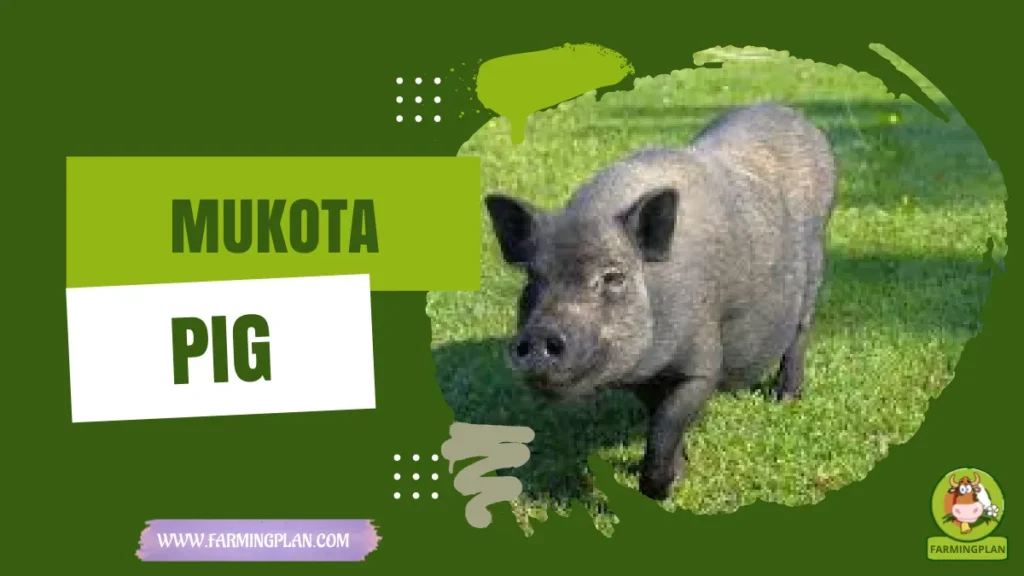If you’re looking for a tough, low-maintenance, and fast-growing goat, the Kiko goat might just be your perfect match. Known for its strength, rapid growth rate, and resistance to parasites, this breed has become a favorite among farmers, breeders, and homesteaders. Originally developed in New Zealand, Kiko goats thrive in natural conditions with minimal care, making them a top choice for both large commercial operations and small backyard farms. Whether you’re searching for kiko goats for sale, exploring the benefits of boer kiko cross goats, or just curious about this impressive meat goat breed, you’re in the right place. Let’s dive into why the Kiko goat is a smart, sustainable choice for your herd.
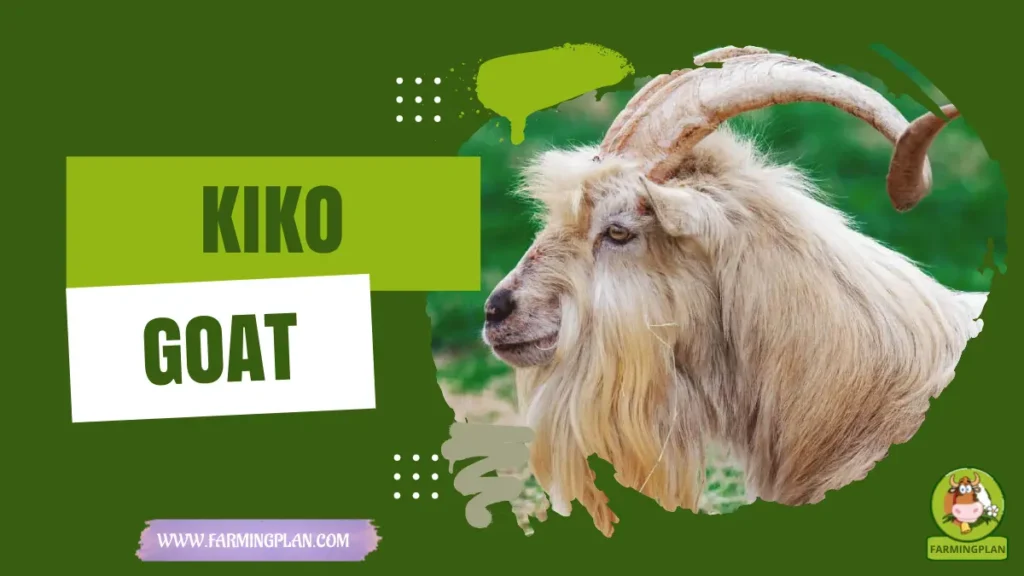
History & Origin of the Kiko Goat
The story of the Kiko goat begins in the lush hills of New Zealand during the 1980s. A pair of dedicated breeders, Anne and Garrick Batten, set out to create a goat that could thrive with little human help. They noticed that New Zealand’s wild, or feral goats, survived well in rough conditions but didn’t grow much meat. So, they crossbred these hardy animals with larger dairy breeds like Saanen, Toggenburg, and Anglo-Nubian bucks. This resilience is a testament to the Kiko goat’s ability to withstand challenging environments, providing farmers, breeders, and homesteaders with a reliable and sustainable investment.
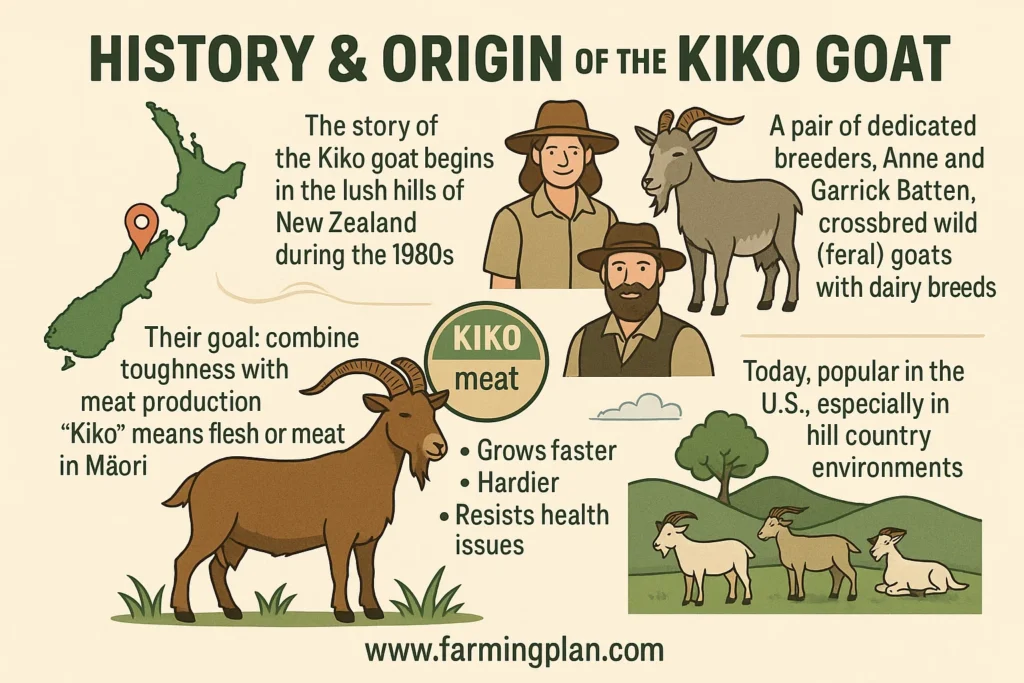
Their goal? To combine toughness with meat production. The result was the Kiko goat—”Kiko” meaning flesh or meat in the Māori language. These goats were stronger, grew faster, and resisted common goat health issues better than many traditional breeds. Kikos were tested under natural conditions with no grain, worming, or hoof trimming. Only the toughest survived, proving their strength. Over time, this new breed caught attention far beyond New Zealand. Today, Kikos are popular in the U.S., especially in hill country environments, thanks to their low-maintenance needs and excellent growth rate. Organizations like the American Kiko Goat Association and the International Kiko Goat Association now help maintain the breed’s quality and growth.
Read More: British Alpine Goat: Meat, Milk & Markings
Characteristics
The Kiko goat is known for being strong, sturdy, and built for survival. These goats have a medium-to-large frame with a muscular body, making them one of the top meat goat breeds today. Their most common color is white, but you’ll also see black, brown, tan, or mixed patterns—color isn’t linked to quality, just personal preference. They usually have long, twisted horns, which give them a bold look. Their hooves are naturally strong and resistant to rot, which makes them perfect for wet or rough terrain. Kikos also have a beard and a thick coat, which helps them adapt to different climates.
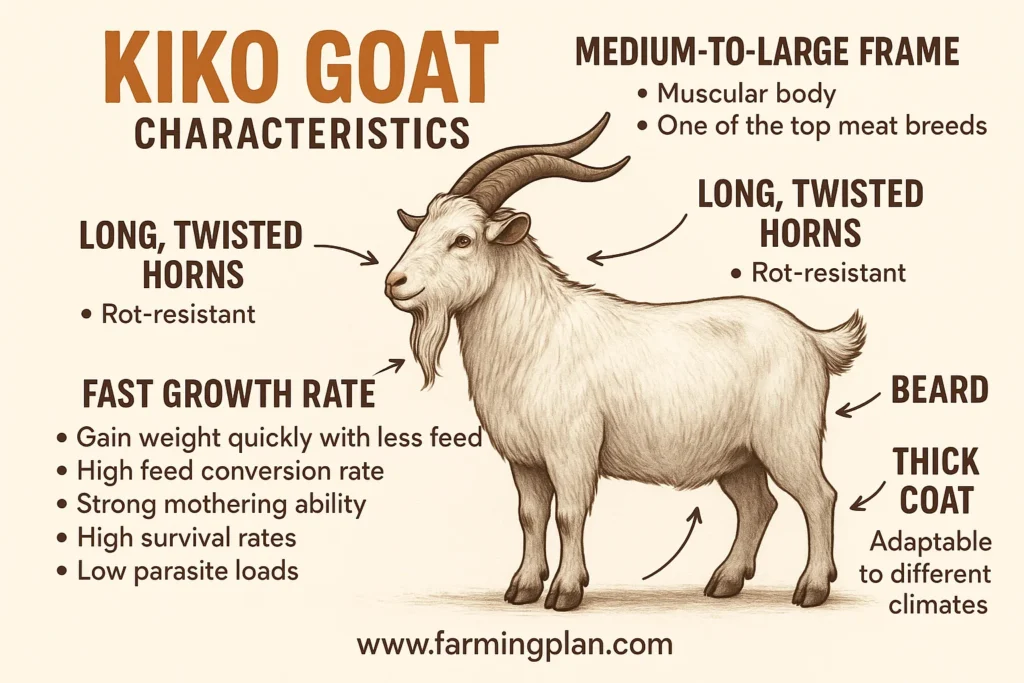
One of their strongest traits is their fast growth rate. Compared to other breeds, Kikos gain weight quickly with less feed. They also have a high feed conversion rate, meaning they turn food into body weight efficiently. That’s great news if you’re raising goats for meat. Thanks to selective breeding, Kikos are known for strong mothering abilities, high survival rates, and low parasite loads. These traits were carefully chosen during their early development, making the Kiko goat a sound and productive breed of meat goat.
Read More: Jakhrana Goat: The Rajasthani Dairy Goats
Nature & Temperament
Kiko goats are as tough on the inside as they are on the outside. These goats are known for their independent and hardy nature, which makes them great for farmers who prefer low-maintenance animals. They’re not overly needy or fussy—they’re the type of goat that just gets to work. This low-maintenance nature of the Kiko goat can help ease the workload of farmers, allowing them to focus on other aspects of their farm.
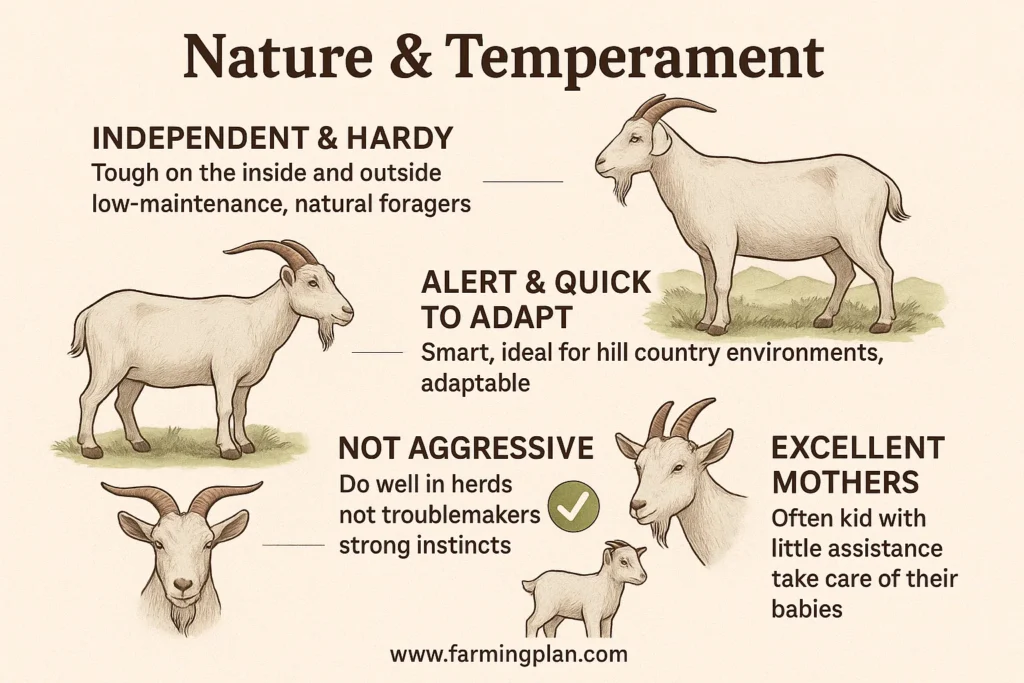
Because Kikos were developed from wild goats, they’re natural foragers. They love to roam and search for their own food, which makes them ideal for hill country environments and rugged pastures. This adaptability means that if you give them space, they’ll take care of themselves, giving you the confidence that your farming decisions are in good hands with the Kiko goat.
While Kikos aren’t as calm or cuddly as some dairy breeds, they are not aggressive. Most owners say they’re smart, alert, and quick to adapt. They do well in herds and aren’t usually troublemakers, especially when raised with proper fencing and structure. Their strong instincts also make them great mothers. Kiko does often kid with little assistance and take excellent care of their babies. For breeders, that’s a big plus.
Read More: African Pygmy Goat: Adorable, Versatile Farm Animal
Kiko Goat Food & Diet
Kiko goats are known for being aggressive foragers. That means they prefer to roam and search for food on their own, eating brush, weeds, shrubs, and grasses. This trait helps reduce feed costs and makes them perfect for land clearing.
Still, to support their growth rate and overall health, it’s a good idea to give them a balanced diet. Quality hay, fresh water, and access to pasture should always be available. You can also offer goat pellets or grains, especially to pregnant does and growing kids, but Kikos generally don’t need much extra feed unless under stress.
Minerals are a must. Use a loose mineral mix made for goats—not blocks—to help with hoof health, parasite resistance, and meat production. Make sure they have clean water at all times. Goats won’t drink dirty water, and dehydration leads to health problems fast.
❝ Kiko goats thrive best when raised on pasture with plenty of forage. Too much grain can cause bloating or hoof issues. Keep it simple and natural.❞
Usage & Purpose
The Kiko goat is mainly raised for one big reason—meat production. It’s one of the most profitable meat goat breeds thanks to its fast growth, high survival rate, and low parasite load. If you’re looking to build a strong, reliable herd, Kikos make an excellent foundation. Many farmers use Kikos to improve their herds through crossbreeding. A popular mix is the Boer Kiko cross, which combines the muscle of Boer goats with the toughness and parasite resistance of Kikos.
This crossbreed not only inherits the fast growth and high survival rate of Kikos but also the meat quality and quantity of Boer goats, making it a great option for breeders wanting the best of both worlds. Besides meat, Kikos are sometimes used in brush control. Because they’re aggressive foragers, they can clear out unwanted weeds and overgrowth in large fields or woodlands, reducing the need for manual labor or chemical control. This makes them helpful workers for landowners who need more than just meat.
They’re not a common dairy goat, but some people do try crossbreeding with dairy breeds like Toggenburg to get dual-purpose traits. However, it’s important to note that while Kikos can produce milk, their milk supply is generally lower than traditional dairy goats, making them more suitable for meat production. Whether you’re farming for profit, raising goats for sale, or managing land, the Kiko goat breed offers strong results with less hassle.
Special Features of the Kiko Goat
What makes the Kiko goat truly special is its ability to thrive where other breeds struggle. These goats were shaped by tough, wild conditions, so they developed traits that help them survive—and succeed—almost anywhere. One of their best qualities is parasite resistance. Internal parasites are a big problem for many goat breeds, but Kikos have a natural edge. This means fewer deworming treatments and better overall herd health. That alone saves farmers time and money.
They also have strong hooves that resist rot, even in wet or muddy areas. This makes them perfect for farmers in humid or rainy regions where hoof issues are common. And because they rarely need hoof trimming, they’re easier to manage long term. Another standout trait? Strong mothering instincts. Kiko does usually give birth without help and raise healthy kids. This trait came from their selective breeding—only the most capable goats passed on their genes.
Kikos also offer a great feed-to-meat ratio. They turn grass and forage into solid muscle quickly, which boosts meat production with lower feed costs. That’s why they’re known as one of the most productive and resilient meat goat breeds out there. They even do well in hill country, rocky terrain, and wide-open pastures. Their twisted horns and alert eyes give them a rugged, confident look that matches their natural toughness.
Health Issues & Prevention
One of the biggest reasons farmers love the Kiko goat is its natural resistance to common goat diseases—especially internal parasites. While no goat is 100% immune, Kikos need fewer treatments than most breeds. That’s a huge benefit for anyone raising goats in humid or parasite-prone areas. Still, it’s important to stay ahead of any health issues. Watch for signs like weight loss, rough coat, diarrhea, or slow growth—these could mean a parasite problem or other illness. Regular fecal tests can help you monitor the parasite load and act before things get serious.
Another thing to watch is hoof rot, especially in wet climates. Although Kikos have strong, healthy hooves, it’s smart to check their feet every few weeks. Keep their living area dry and clean to prevent bacteria from spreading. Make sure your goats always have fresh water, clean shelter, and a steady supply of minerals. A balanced diet supports their immune system and helps prevent nutritional deficiencies that can lead to bigger problems.
If you’re buying Kiko goats, ask for proof of health, including vaccination history and recent parasite checks. A healthy start makes a big difference. Kikos don’t usually need lots of vet visits, but that doesn’t mean ignoring them. Spend time with your herd. You’ll notice problems early just by watching how they move, eat, or act.
Step-by-Step Guide
Raising a Kiko goat is rewarding, especially when you start with the right plan. Here’s a clear, step-by-step guide to help you build a healthy, productive herd.
Step 1: Set Up Safe Fencing
Kiko goats are active and curious, so use strong fencing like woven wire or electric fencing. Make sure it’s at least 4 feet high to keep them in and predators out. Avoid cheap wire—they’ll test it.
Step 2: Build a Simple Shelter
Kikos don’t need fancy barns. A basic three-sided shelter is enough to protect them from rain, wind, and snow. Keep the bedding dry using straw or wood shavings. Good airflow helps avoid respiratory issues.
Step 3: Choose Healthy Stock
Buy your goats from a trusted breeder. Look for signs of health: bright eyes, smooth coat, and strong body. Ask for Kiko buck or doe registration papers from groups like the American Kiko Goat Association or International Kiko Goat Association.
Step 4: Feed the Right Way
Provide free-choice forage or pasture, quality hay, and clean water. Use loose minerals made for goats—not salt blocks. Only offer grain if needed (like for pregnant or growing goats).
Step 5: Watch for Parasites
Kikos resist parasites well, but don’t ignore signs. Use the FAMACHA system to check eyelid color for anemia and test for worms every few months. Keep pastures clean and rotate grazing areas.
Step 6: Breeding and Kidding
Breeding usually starts in the fall. Kiko does are easy kidders and rarely need help. Provide a quiet space and clean bedding. Most does have twins or triplets. Keep an eye on kids to ensure they nurse and stand quickly.
Step 7: Keep Records
Track your herd’s weight gain, growth rate, and kidding history. Use simple notebooks or farm management apps. These records help you improve your herd over time.
Step 8: Routine Care
Do monthly hoof checks, offer minerals, and keep shelter clean. Handle your goats often so they stay calm and used to people. This makes care easier.
Expert Tips & Best Practices for Raising Kiko Goats
Raising Kiko goats can be an incredibly rewarding experience, but to get the most out of your herd, there are a few expert tips and best practices you should follow. Here are some strategies that experienced goat owners swear by:
Crossbreed for Better Meat Production
If you’re looking to maximize meat yield, consider crossbreeding your Kiko goats with Boer goats. The Boer Kiko cross combines the muscle mass of Boer goats with the Kiko’s resilience and fast growth. This cross produces highly marketable meat goats with excellent feed conversion rates.
Focus on Parasite Resistance
One of the Kiko’s standout features is its resistance to internal parasites. While they’re naturally resistant, it’s still important to rotate pastures and manage herd density to avoid parasite buildup. Keep track of fecal egg counts regularly, especially during wet months when parasites thrive.
Invest in Good Fencing
Since Kikos are natural foragers, they need solid fencing to keep them where you want them. Opt for woven wire fencing that’s at least 4 feet high, and add electric fencing for extra protection if needed. Make sure the fencing is sturdy enough to handle their curious and energetic nature.
Don’t Overfeed Grains
Kiko goats don’t require much grain. In fact, too much grain can cause bloating or digestive issues. Stick to grass, brush, and high-quality hay as their main food sources, and use grains sparingly, mainly during pregnancy or growth phases.
Monitor Health Regularly
Even though Kikos are generally healthy and low-maintenance, it’s still important to monitor them regularly. Keep an eye on their hoofs, eyes, and coat for any signs of trouble. Early detection of problems will save time and money in the long run.
Keep a Balanced Breeding Program
If you’re breeding Kikos, always focus on selective breeding. Choose strong, healthy goats that meet your production goals, whether for meat, size, or parasite resistance. By focusing on breeding healthy, productive goats, you’ll ensure the continued success of your herd.
Invest in Good Goat Handling Equipment
Having the right goat handling equipment, such as a catching pen, hoof trimmers, and a kidding kit, will make your job much easier. These tools are essential for managing your herd and ensuring quick, effective care.
Where to Buy Kiko Goats: Finding the Right Source
If you’re ready to add Kiko goats to your farm or herd, there are plenty of places where you can find healthy, high-quality stock. Here’s where to start:
Kiko Goat Associations
A great place to begin your search is through Kiko goat associations like the American Kiko Goat Association or the International Kiko Goat Association. These organizations have breeder directories, offering a list of trusted breeders who meet high standards for raising healthy Kiko goats. Many breeders within these associations focus on purebred Kikos and offer registration options.
Online Marketplaces and Listings
Websites like Craigslist and GoatFinders have Kiko goats for sale listings from various sellers. These can be a good option if you’re looking for local breeders or trying to find Kiko goats for sale near me. Make sure to ask about the goats’ health history, parasite resistance, and breeding lines.
Local Livestock Auctions
Check out your local livestock auction or sale barn. These events often feature Kiko bucks, does, and kids for sale. While this is a less predictable option, it can be a great way to find goats at competitive prices. Be sure to check the health of the goats before bidding.
Online Goat Forums and Facebook Groups
There are several online forums and Facebook groups dedicated to goat breeding, including Kikos. Joining these communities is a great way to connect with breeders and other Kiko goat owners. Some members even offer Boer Kiko cross goats or purebred Kiko buck for sale.
Word of Mouth
Sometimes, the best recommendations come from fellow farmers and ranchers. Ask around in your local farming community or at agricultural events. Many breeders may not have online listings but are willing to sell when asked.
Specialized Goat Breeders
If you’re looking for high-quality breeding stock or specific traits (like a Kiko buck for sale), consider reaching out to specialized breeders who focus on genetics and selective breeding. These breeders can help you build a herd with excellent meat production, parasite resistance, and growth rates.
Kiko Goat Farms
Many farmers who breed Kiko goats sell directly from their farms. Look for Kiko goat farms in your area and ask about their breeding program, prices, and any other details you need. Visiting the farm gives you the chance to inspect the goats’ living conditions, which is important for ensuring you buy healthy, well-cared-for animals.
FAQ
What is a Kiko goat?
The Kiko goat is a hardy meat breed developed in New Zealand by crossbreeding local feral goats with imported dairy breeds like Saanen, Toggenburg, and Anglo-Nubian. The breed was established in the 1980s, focusing on rapid growth and adaptability to harsh conditions.
How long do Kiko goats live?
Kiko goats typically live between 8 to 12 years, with proper care potentially extending their lifespan beyond this range.
Are Kiko goats good for milk production?
While Kiko goats can produce milk, they are primarily bred for meat. Their milk production is adequate but not as high as specialized dairy breeds like Saanen or Toggenburg.
What is the best hay for Kiko goats?
Alfalfa hay is ideal for Kiko goats, providing higher protein, vitamins, and minerals compared to grass hay, supporting their growth and overall health.
Do Kiko goats need shelter?
Despite their hardiness, Kiko goats benefit from a dry, three-sided shelter to protect them from extreme weather conditions, ensuring their comfort and health.
Conclusion
The Kiko goat is a robust meat breed originating from New Zealand, developed for rapid growth and adaptability in challenging environments. With characteristics like parasite resistance, minimal health issues, and strong maternal instincts, Kikos are well-suited for farmers seeking a low-maintenance, high-yield meat goat. While they can produce milk, their primary strength lies in meat production. Proper care, including providing adequate shelter and nutrition, ensures their longevity and productivity. Whether you’re a seasoned farmer or a newcomer, the Kiko goat offers a reliable and efficient addition to any livestock operation.

